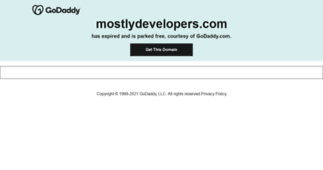Mostly Developers
Enter a key term, phrase, name or location to get a selection of only relevant news from all RSS channels.
Enter a domain's or RSS channel's URL to read their news in a convenient way and get a complete analytics on this RSS feed.
Unfortunately Mostly Developers has no news yet.
But you may check out related channels listed below.
[...] Fiddler so that it loads your new configuration options. 4) Next, you’ll need to setup your Android device to run it’s connectivity through Fiddler. Navigate to Settings >> Wireless & [...]
[...] development. An Android Virtual Device (AVD) is an emulator configuration which models an Android device. Before you can run your application, you have to define an AVD to run and test it on. [...]
[...] Name: This is the title of your application. This will be seen by your users on an Android device. It is good to be descriptive, but keep it somewhat short. Package Name: This guy is a bit [...]
[...] touch on what each of the AVD options do. Name: The name of the AVD. Target: The API level to which you want to test against. Typically this is the API level that you setup for [...]
[...] assigned. Pick the API Level for the build target you previously chose. So again, the Min SDK Version number will match the [...]
[...] in Eclipse. My first obstacle I encountered was creating a new Android Project. When creating a new project in Eclipse, you are presented with a “New [...]
[...] how to setup your machine to program for Android and I also went over how to create an Android project. In this post I’m going to go over Android Virtual Devices and how they are used in [...]
[...] than or equal to what your application is set to. CPU/ABI: This is intended for Android devices which run on non-ARM processor architectures. From my research, I’ve not seen any [...]
[...] ’s source code will reside under. The tricky part is the realization that on Android devices, the package name MUST be unique. So if two applications are running under the same [...]
[...] , my wild guess is 6.0 will be Kiwi… Distribution API Level 5.0 Jelly Bean 15-16 4.0 Ice Cream Sandwich 14-15 3.x.x Honeycomb 11-13 2.3.x Gingerbread 9-10 2.2 Froyo 8 2.1 Eclair 7 1.6 Donut [...]
[...] to show you how to setup Fiddler to inspect web traffic from an Android device running Ice Cream Sandwich. 1) First, if you don’t have Fiddler yet, you can download it here. 2) Second, you need to [...]
[...] convert from was being hit, but the convert back (updating the object from the UI via two-way data binding) was not being hit. So one-way was working, but two-way was not… 4) Are you [...]
[...] . Snapshot: This option is a newer option which helps speed up the starting of the Android emulator. You can enable this so that the emulator will launch quicker and when you stop it, [...]
[...] Android Gingerbread emulator to use. Next, I’ll briefly touch on what each of the AVD options do. Name: The name of the AVD. Target: The API level to which you want to test against. [...]
[...] Fiddler so that it loads your new configuration options. 4) Next, you’ll need to setup your Android device to run it’s connectivity through Fiddler. Navigate to Settings >> Wireless & [...]
[...] development. An Android Virtual Device (AVD) is an emulator configuration which models an Android device. Before you can run your application, you have to define an AVD to run and test it on. [...]
[...] Name: This is the title of your application. This will be seen by your users on an Android device. It is good to be descriptive, but keep it somewhat short. Package Name: This guy is a bit [...]
Related channels
-
PHP Development India, Outsource PHP Programmers India, PHP Freelancers I...
Software development in Mumbai, ERP Development, CRM Development, TV Web portal, Diamond Jewelery Portal Development, Ap...
-
Droid Tutors
Your One Stop Source for Everything Android!
-
Web Development Company - Web Designing, Joomla Development Outsourcing S...
Web Development Company: Nooglesoft Website Design and Web Development Company specializing in Outsourcing,Web Site Deve...
-
NXTTECH
Android And Tech Tips&Tricks
-
Welcome to Erbium Group - ERBIUM GROUP- Open CMS customisation UK joomla ...
Erbium Group provides web services like Web Development, web development outsourcing UK,open CMS development London,Joom...

